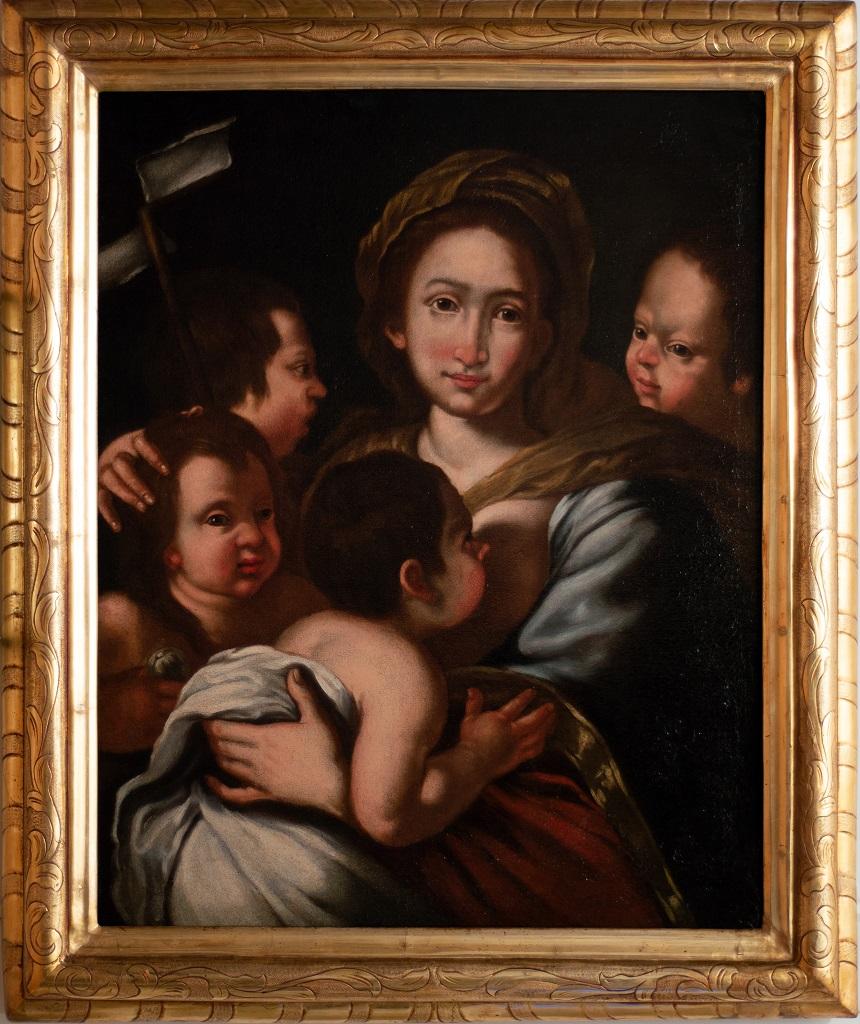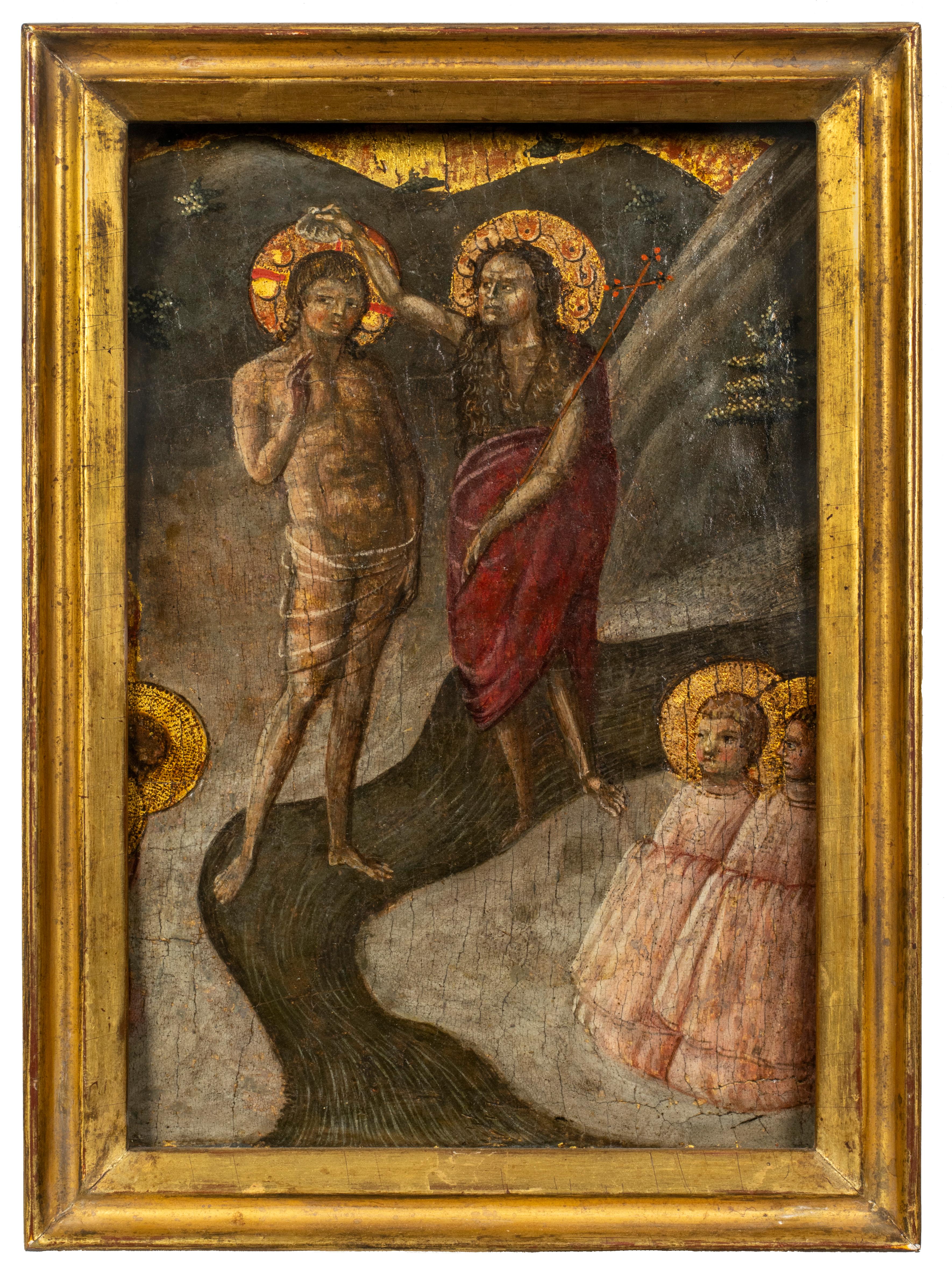Items Similar to Skull with Sacred Writings and Tablets of the Law - Tempera on Cardboard
Want more images or videos?
Request additional images or videos from the seller
1 of 4
French Painter 18th Century Skull with Sacred Writings and Tablets of the Law - Tempera on Cardboard18th Century
18th Century
About the Item
Skull with Sacred Writings and Tablets of the Law is a superb and colorful tempera on cardboard, realized in 1766 by an anonymous artist of the French School of XVIII century.
On the back of the frame, there is an antique cardboard label comìng from the original assembly with the written in black ink that points out the author: "Peint (...) M.lle Becquey de Viliers à Paris 1766".
In excellent conditions, including a modern wooden frame, cm 25 x 26.5.
There are deep religious meanings behind this composition with a skull leaning on books and surrounded by Sacred Writings, Tablets of Law, an hourglass, a crucifix, and some compasses. The theme of the vanitas, the fleetingness of time are the elements unify the composition.
It is amusing to read the hand-written and perfectly readbles religious warnings or the preys under the skull!
- Creator:French Painter 18th Century
- Creation Year:18th Century
- Dimensions:Height: 9.77 in (24.8 cm)Width: 10.48 in (26.6 cm)Depth: 0.48 in (1.2 cm)
- Medium:
- Movement & Style:
- Period:
- Condition:Insurance may be requested by customers as additional service, contact us for more information.
- Gallery Location:Roma, IT
- Reference Number:
About the Seller
4.9
Platinum Seller
These expertly vetted sellers are 1stDibs' most experienced sellers and are rated highest by our customers.
1stDibs seller since 2017
6,767 sales on 1stDibs
Typical response time: 3 hours
- ShippingRetrieving quote...Ships From: Monaco, Monaco
- Return PolicyA return for this item may be initiated within 14 days of delivery.
More From This SellerView All
- Christian Charity - Tempera by the circle of Bernardo Strozzi - 1630sBy Bernardo StrozziLocated in Roma, ITChristian Charity is an original Old Master Painting realized in the first half of the XVII Century, most probably in the 1630s, by one of the pupils of the Italian artist Bernardo Strozzi...Category
1630s Old Masters Figurative Paintings
MaterialsTempera, Canvas
- The Knight - painting - XVII centuryLocated in Roma, ITThe Knight is an original oil painting on canvas realized during the XVII century by an anonymous artist. Provenance: Pecci-Blunt collection. Good condition...Category
17th Century Old Masters Figurative Paintings
MaterialsCanvas, Oil
- Still Life with Fishes and Oysters - Oil on Canvas - 17th CenturyLocated in Roma, ITStill life with fishes and oysters is an original oil on canvas realized in the 17th Century by Neapolitan School Master. Impressive in size as well as for its vivid representation o...Category
17th Century Old Masters Still-life Paintings
MaterialsOil
- A Rich Merchant - Painting by Unknown - 18th CenturyLocated in Roma, ITA rich merchant is an original old master artwork realized in the 18th Century. Mixed colored oil painting on canvas depicting a merchant looking at a coin in his left hand. Provena...Category
18th Century Old Masters Figurative Paintings
MaterialsOil
- Cardinal with Missive - Painting by Unknown - 17th CenturyLocated in Roma, ITCardinal with missive is an original old master artwork realized in the 17th Century. Mixed colored oil painting on canvas. Provenance: Italy. Avery precoius artwork depicting a ca...Category
17th Century Old Masters Figurative Paintings
MaterialsOil
- Virgin with Child - Painting by Theodor Mathon - 17th CenturyLocated in Roma, ITVirgin Mary and Jesus is an original old masters' artwork realized by the Flemish painter Theodor Mathon (1606-1676) in the 17th century. Mixed ...Category
17th Century Old Masters Figurative Paintings
MaterialsOil
You May Also Like
- The Resurrection of ChristLocated in New York, NYProvenance: with “Mr. Scheer,” Vienna, by July 1918; where acquired by: Jindřich Waldes, Prague, 1918–1941; thence by descent to: Private Collection, New York Literature: Rudolf Kuchynka, “České obrazy tabulové ve Waldesově obrazárně,” Památky archeologické, vol. 31 (1919), pp. 62-64, fig. 5. Jaroslav Pešina, “K datování deskových obrazů ve Waldesově obrazárně,” Ročenka Kruhu pro Pěstování Dějin Umění: za rok (1934), pp. 131-137. Jaroslav Pešina, Pozdně gotické deskové malířství v Čechách, Prague, 1940, pp. 150-151, 220. Patrik Šimon, Jindřich Waldes: sběratel umění, Prague, 2001, pp. 166, 168, footnote 190. Ivo Hlobil, “Tři gotické obrazy ze sbírky Jindřicha Waldese,” Umění, vol. 52, no. 4 (2004), p. 369. Executed sometime in the 1380s or 1390s by a close associate of the Master of the Třeboň Altarpiece, this impressive panel is a rare work created at the royal court in Prague and a significant re-discovery for the corpus of early Bohemian painting. It has emerged from an American collection, descendants of the celebrated Czech industrialist and collector Jindřich Waldes, who died in Havana fleeing Nazi-occupied Europe. The distinctive visual tradition of the Bohemian school first began to take shape in the middle of the fourteenth century after Charles IV—King of Bohemia and later Holy Roman Emperor—established Prague as a major artistic center. The influx of foreign artists and the importation of significant works of art from across Europe had a profound influence on the development of a local pictorial style. Early Italian paintings, especially those by Sienese painters and Tommaso da Modena (who worked at Charles IV’s court), had a considerable impact on the first generation of Bohemian painters. Although this influence is still felt in the brilliant gold ground and the delicate tooling of the present work, the author of this painting appears to be responding more to the paintings of his predecessors in Prague than to foreign influences. This Resurrection of Christ employs a compositional format that was popular throughout the late medieval period but was particularly pervasive in Bohemian painting. Christ is shown sitting atop a pink marble sarcophagus, stepping down onto the ground with one bare foot. He blesses the viewer with his right hand, while in his left he holds a triumphal cross with a fluttering banner, symbolizing his victory over death. Several Roman soldiers doze at the base of the tomb, except for one grotesque figure, who, beginning to wake, shields his eyes from the light and looks on with a face of bewilderment as Christ emerges from his tomb. Christ is wrapped in a striking red robe with a blue interior lining, the colors of which vary subtly in the changing light. He stands out prominently against the gold backdrop, which is interrupted only by the abstractly rendered landscape and trees on either side of him. The soldiers’ armor is rendered in exacting detail, the cool gray of the metal contrasting with the earth tones of the outer garments. The sleeping soldier set within a jumble of armor with neither face nor hands exposed, is covered with what appears to be a shield emblazoned with two flies on a white field, somewhat resembling a cartouche (Fig. 1). This may be a heraldic device of the altarpiece’s patron or it may signify evil, referencing either the Roman soldiers or death, over both of which Christ triumphs. This painting formed part of the collection assembled by the Czech industrialist and founder of the Waldes Koh-i-noor Company, Jindřich Waldes, in the early twentieth century. As a collector he is best remembered for establishing the Waldes Museum in Prague to house his collection of buttons (totaling nearly 70,000 items), as well as for being the primary patron of the modernist painter František Kupka. Waldes was also an avid collector of older art, and he approached his collecting activity with the goal of creating an encyclopedic collection of Czech art from the medieval period through to the then-present day. At the conclusion of two decades of collecting, his inventory counted 2331 paintings and drawings, 4764 prints, and 162 sculptures. This collection, which constituted the Waldesova Obrazárna (Waldes Picture Gallery), was first displayed in Waldes’ home in Prague at 44 Americká Street and later at his newly built Villa Marie at 12 Koperníkova Street. This Resurrection of Christ retains its frame from the Waldes Picture Gallery, including its original plaque “173 / Česky malíř z konce 14 stol.” (“Czech painter from the end of the 14th century”) and Waldes’ collection label on the reverse. The Resurrection of Christ was one of the most significant late medieval panel...Category
15th Century and Earlier Old Masters Paintings
MaterialsTempera, Panel
- Baptism of ChristLocated in New York, NYProvenance: Achillito Chiesa, Milan Luigi Albrighi, Florence, by 1 July 1955 with Marcello and Carlo Sestieri, Rome, 1969 Private Collection, Connecticut Exhibited: Mount Holyoke College Art Museum, South Hadley, Massachusetts (on loan, 2012) Literature: Carlo Volpe, “Alcune restituzioni al Maestro dei Santi Quirico e Giulitta,” in Quaderni di Emblema 2: Miscellanea di Bonsanti, Fahy, Francisci, Gardner, Mortari, Sestieri, Volpe, Zeri, Bergamo, 1973, pp. 19-20, fig. 18, as by the Master of Saints Quiricus and Julitta (now identified as Borghese di Piero). This fine predella panel depicting the Baptism...Category
15th Century and Earlier Old Masters Figurative Paintings
MaterialsWood Panel, Tempera
- Russian Icon 16th century The Battle of the Novogorodians with the SuzdaliansBy Russian SchoolLocated in London, GBThe Battle of the Novogorodians with the Suzdalians 16th century Size 50.5 x 47.5 x 3 cm. The icon is located in the Russian Federation. There is an expert opinion from leading R...Category
16th Century Old Masters Paintings
MaterialsWood, Egg Tempera, Wood Panel
- Carlo Grubacs(Venetian master)- Pair of 19th century Venice landscape paintingsBy Carlo GrubacsLocated in Varmo, ITCarlo Grubacs (Perasto 1801 - Venice 1870) - Venice, pair of views of Piazza S. Marco and the Basin towards the Riva degli Schiavoni. 11 x 16 cm without frame, 29.5 x 34.5 cm with f...Category
Mid-19th Century Old Masters Landscape Paintings
MaterialsTempera, Paper
- Carlo Grubacs(Venetian master)- Pair of 19th century Venice landscape paintingsBy Carlo GrubacsLocated in Varmo, ITCarlo Grubacs (Perasto 1801 - Venice 1870) - Venice, pair of views of Piazza S. Marco and the Piazzetta towards the Clock Tower. 19 x 24 cm without frame, 25 x 30 cm with frame. An...Category
Mid-19th Century Old Masters Landscape Paintings
MaterialsTempera, Paper
- Circa 1400, Spanish school of 'The Prophet Daniel', tempera on panel with gildinLocated in Petworth, West SussexSpanish school, circa 1400 The prophet Daniel Tempera on panel with gilding 35.1/4 x 10.5/8 in. (89.5 x 28 cm.) Condition: The painting has been recently stabilised and cleaned up. ...Category
15th Century and Earlier Old Masters Figurative Paintings
MaterialsWood Panel, Tempera
Recently Viewed
View AllMore Ways To Browse
French France 18th Century
18th Century Framed
18th And Older
Paintings Of The 18th Century
18th Century French Frame
18th Century French Art
French 18th Century Art
18th Century Paris
Masters Of 18th Century
Antique 18th Century Frame
18th Century Old Masters
18th Century School
French Painting 18th
Paintings France 18th Century
18th Century Paintings French
18th Century French Paintings
Antique Law
Antique 18th Paintings




